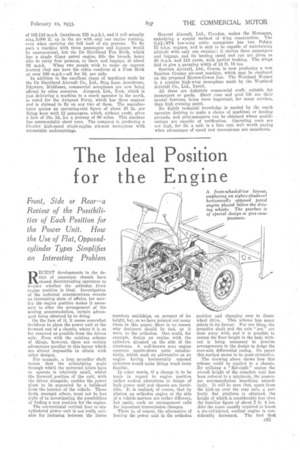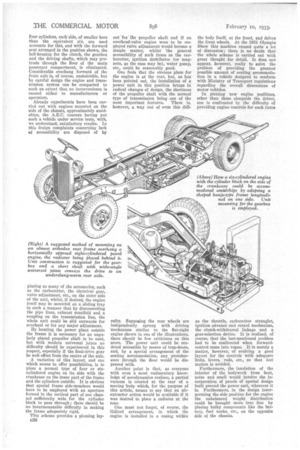The Ideal Position for the Engine
Page 85

Page 86

If you've noticed an error in this article please click here to report it so we can fix it.
RECENT developments in the design of passenger chassis have caused discriminating operators to wonder whether the orthodox front engine position is ideal. Investigation of the technical considerations reveals an interesting state of affairs, for moving the engine position makes it necessary to alter the arrangement of the seating accommodation, certain advanages being obtained by so doing.
On the face of it, it seems somewhat invidious to place the power unit at the forward end of a chassis, where it is as far removed as possible from the driven axle. Even with the existing scheme of things, however, there are certain advantages peculiar to this layout which are almost impossible to obtain with other designs.
For example, a long propeller shaft means that the articulating angle through which the universal joints have to operate is relatively small, whilst the forward position of the unit, with the driver alongside, enables the power plant to be separated by a bulkhead from the interior of the vehicle. These facts, amongst others, must not be lost sight of in investigating the possibilities of finding a new position for the engine.
The conventional vertical four or sixcylindered power unit is not really suitable for inclusion between the frame members amidships, on account of its height, but, as we have pointed out many times in this paper, there is no reason why designers should be tied, as it were, to the orthodox. One could, for example, design an engine with the cylinders situated on the side of the crankcase. A well-known aero engine operates upside-down quite satisfactorily, whilst such an alternative as an engine having horizontally opposed cylinders would make things much more feasible.
In other words, if a change is to be made in regard to engine position rather radical alterations in design of both power unit and chassis are inevitable. It is realized, of course, that by placing an orthodox engine at the side of a vehicle matters are rather different, but again, such an arrangement calls for important transmission changes.
There is, of course, the alternative of leaving the power unit in the orthodox position and changing over to frontwheel drive. This scheme has many points in its favour. For one thing, the propeller shaft and the axle " pot " are done away with, and it is possible to reduce the floor height in the body without it being necessary to provide arrangements in the design to dodge the rear-axle differential casing. On paper this method seems to be most attractive.
The drawing above shows how this scheme could be applied to a chassis. By utilizing a " fiat-eight " engine the overall height of the complete unit has been reduced to a minimum, the passenger accommodation benefiting accordingly. It will be seen that, apart from the kick-up over the rear axle, a perfectly fiat platform is obtained, the height of which is considerably less than the familiar figure of about 2 ft. 4 ins. Also the space usually required to house six-cylindered, vertical engine is considerably decreased. The fact that four cylinders, each'side, of smaller bore than the equivalent six, are used accounts for this, and with the forward seat arranged in the position shown, the bell-housing for the clutch, the gearbox and the driving shafts, which may protrude through the floor of the main passenger compartment, is eliminated. Considerable overhang forward of the front axle is, of course, undesirable, but by careful design the engine and transmission system can be compacted to such an extent that no inconvenience is caused either to manufacturers or operators.
Already experiments have been carried out with engines mounted on the side of the chassis, approximately amidships, the A.E.C. concern having put such a vehicle under service tests, with, we understand, satisfactory results. In this design complaints concerning lack of accessibility are disposed of by placing as many of the accessories, such as the carburetter, the electrical gear, valve adjustment, etc., on the Outer side of the unit, whilst, if desired, the engine itself may be mounted on a sliding tray in such a manner that by disconnecting the pipe lines, exhaust manifold and a coupling on the transmission line, the whole unit could be slid outwards for overhaul or for any major adjustment.
By locating the power plant outside the frame it is necessary for an angularly placed propeller shaft to be used, but with modern universal joints no difficulty should be experienced in this respect, especially if the final-drive gear be well offset from the centre of the axle.
A variation of this layout, and one which seems to offer possibilities, is to place a normal type of four or sixcylindered engine on its side with the crankcase on the inner part of the frame and the cylinders outside. It ia obvious that special frame side-members would have to be employed with an aperture formed in the vertical part of one channel sufficiently wide for the cylinder block to pass through ; there should be no insurmountable difficulty in making the frame adequately rigid.
This scheme provides a pleasing layc36
out .for'tbe propeller shaft and if an overhead-valve engine were to be employed valve adjustment would become a simple matter, whilst the general accessibility of such items as the carburetter, ignition distributor (or magneto, as the case may be), water pump, etc., could be reasonably good.
One feels that the obvious place for the engine is at the rear, but, as has been pointed out, the installation of a power unit in this position brings in radical changes of design, the shortness of the propeller shaft with the normal type of transmission being one of the most important features. There is, however, a way out of even this dill culty. Supposing the rear wheels are independently sprung with driving mechanism similar to the flat-eight engine shown in one of the illustrations, there should be few criticisms on this score. The power unit could be rendered accessible by means of trap-doors, and, by a special arrangement of the seating accommodation, any protuberance through the floor would be dispensed with.
Another point is that, as everyone with even a most rudimentary knowledge of aerodynamics realizes, a partial vacuum is created at the rear of a moving body which, for the purpose of this article, means to say that an airextractor action would be available if it was desired to place a radiator at the rear.
One must not forget, of course, the Gilford arrangement, in which the engine is installed in a casing within the body itself, at the front, and drives the front wheels. At the 1931 Olympia Show this machine caused quite a lot of discussion ; there is no doubt that the whole scheme is carried out with great thought for detail. It does not appear, however, really to solve the problem of providing the greatest possible amount of seating accommodation in a vehicle designed to conform with Ministry of Transport regulations regarding the overall dimensions of motor vehicles.
In plotting new engine positions, other than those alongside the driver, one is confronted by the difficulty of providing engine controls for such items
as the throttle, carburetter strangler, ignition advance and retard mechanism, the clutch-withdrawal linkage and a gear-selection device. It is realized, of course, that the last-mentioned problem had to he confronted when forwardcontrol came into vogue. It is merely a matter, however, of evolving a good layout for the controls with adequate links, levers, rods, etc., so that lost motion is avoided.
Furthermore, the insulation of the interior of the bodywork from heat, noise and smell would involve the incorporation of panels of special design built around the power unit, wherever it is. Furthermore, in the design incorporating the side position for the engine the unbalanced weight distribution could be brought more into line by placing bulky, components like the battery, fuel tanks, etc., on the opposite side of the chassis.




































































































































































